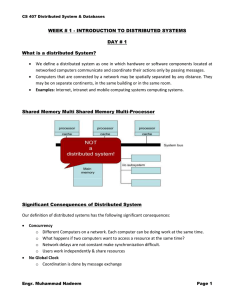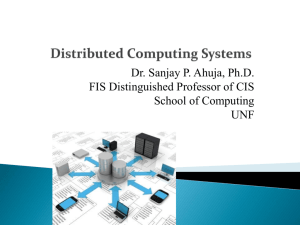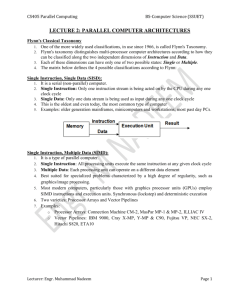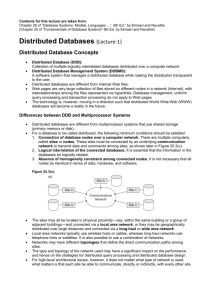CS 407 Distributed System & Databases
advertisement
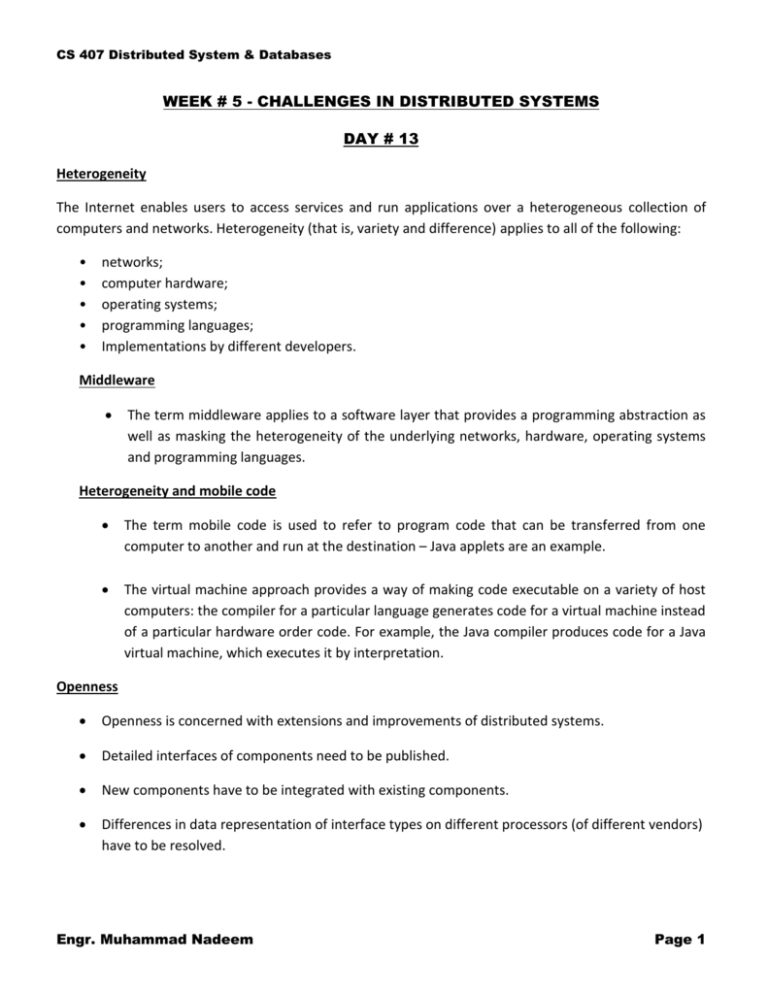
CS 407 Distributed System & Databases WEEK # 5 - CHALLENGES IN DISTRIBUTED SYSTEMS DAY # 13 Heterogeneity The Internet enables users to access services and run applications over a heterogeneous collection of computers and networks. Heterogeneity (that is, variety and difference) applies to all of the following: • • • • • networks; computer hardware; operating systems; programming languages; Implementations by different developers. Middleware The term middleware applies to a software layer that provides a programming abstraction as well as masking the heterogeneity of the underlying networks, hardware, operating systems and programming languages. Heterogeneity and mobile code The term mobile code is used to refer to program code that can be transferred from one computer to another and run at the destination – Java applets are an example. The virtual machine approach provides a way of making code executable on a variety of host computers: the compiler for a particular language generates code for a virtual machine instead of a particular hardware order code. For example, the Java compiler produces code for a Java virtual machine, which executes it by interpretation. Openness Openness is concerned with extensions and improvements of distributed systems. Detailed interfaces of components need to be published. New components have to be integrated with existing components. Differences in data representation of interface types on different processors (of different vendors) have to be resolved. Engr. Muhammad Nadeem Page 1 CS 407 Distributed System & Databases Security Many of the information resources that are made available and maintained in distributed systems have a high intrinsic value to their users. Their security is therefore of considerable importance. Security for information resources has three components: Confidentiality (protection against disclosure to unauthorized individuals) Integrity (protection against alteration or corruption) Availability (protection against interference with the means to access the resources). Example In a distributed system, clients send requests to access data managed by servers, resources in the networks: o Doctors requesting records from hospitals o Users purchase products through electronic commerce Security is required for: o Concealing the contents of messages: security and privacy o Identifying a remote user or other agent correctly (authentication) New challenges: o Denial of service attack o Security of mobile code Both of these challenges can be met by the use of encryption techniques developed However, the following two security challenges have not yet been fully met: Denial of service attacks Another security problem is that a user may wish to disrupt a service for some reason. This can be achieved by bombarding the service with such a large number of pointless requests that the serious users are unable to use it. This is called a denial of service attack. Security of mobile code Mobile code needs to be handled with care. Consider someone who receives an executable program as an electronic mail attachment: the possible effects of running the program are unpredictable. Engr. Muhammad Nadeem Page 2 CS 407 Distributed System & Databases WEEK # 5 - CHALLENGES IN DISTRIBUTED SYSTEMS DAY # 14 Scalability A system is described as scalable if it will remain effective when there is a significant increase in the number of resources and users. Example: the Internet is one such distributed system. Challenges in the designing of scalable distributed systems include: Controlling the cost of physical resources. For a system with n users to be scalable, the quantity/cost of physical resources to support them must be at most O(n), i.e., proportional to n. So if a single file server can support 20 users, 2 such servers should support 40 users. Controlling the performance loss. Algorithms that use hierarchic storage structures (e.g. LDAP) scale better than those that use linear (e.g. flat file data tables) structures. Even with hierarchic structures an increase in size (of data) will result in some performance loss since the the time taken to access hierarchically structured data is O(log n), where n is the size of the data set. Preventing software resources running out. Lack of scalability is shown by the 32-bit IP addresses. The new version (IP v6) will use 128 bit addresses. Avoiding performance bottlenecks. Algorithms should be decentralized to avoid performance bottlenecks. E.g. the name table in DNS was originally kept in a single master file. This became a performance bottleneck. It was then partitioned between DNS servers located throughout the Internet and administered locally. Caching and replication can also improve performance of resources that are heavily used. Failure Handling Failures in distributed systems are partial – some components fail while others continue to function. Hence failure handling can be difficult. Techniques can be used to: Engr. Muhammad Nadeem Page 3 CS 407 Distributed System & Databases Detect failures: E.g. use checksums to detect corrupt data in a file/message. Other times failure can only be suspected (e.g. a remote server is down) but not detected and the challenge is to manage in the presence of such failures. Mask Failures: Some failures that have been detected can be masked/hidden or made less severe. E.g. messages can be retransmitted when then fail to be acknowledged. This might not help if the network is severely congested and in this case even the retransmission may not get through before timeout. Another e.g. File data can be written to a pair of disks so that if one is corrupted, the other may still be correct (redundancy to achieve fault-tolerance). Tolerate Failures: Most of the services on the Internet exhibit failures and it is not practical to detect or mask all the possible kinds of failures. In such cases, clients can be designed to tolerate failures. E..g. a web browser cannot reach a web server it does not make the user wait forever. It gives a message indicating that the server is unreachable and the user can try later. Recovery from failures: This involves the design of software so that the state of permanent data can be recovered or “rolled back” after a server has crashed. E.g. database servers have a transaction handling ability that enables them to roll back a transaction that was not completed. Redundancy: a) There should be at least two different routes between any two routers in the Internet. b) In the DNS, every name table is replicated in at least two different servers. c) A database may be replicated in several servers to ensure that the data remains accessible after the failure of a single server; the servers can be designed to detect faults in their peers; when a fault is detected in one server, clients are redirected to the remaining servers. Distributed systems exhibit a high degree of availability in the face of hardware faults. The availability of a system is a measure of the proportion of time that it is available for use. E.g. if one server goes down, client requests can be directed to another server and the service continues to be available. Engr. Muhammad Nadeem Page 4 CS 407 Distributed System & Databases WEEK # 5 - CHALLENGES IN DISTRIBUTED SYSTEMS DAY # 15 Concurrency Components in distributed systems are executed in concurrent processes. Components access and update shared resources (e.g. variables, databases, device drivers). Integrity of the system may be violated if concurrent updates are not coordinated. o Lost updates o Inconsistent analysis Transparency Distributed systems should be perceived by users and application programmers as a whole rather than as a collection of cooperating components. Transparency has different aspects. These represent various properties that distributed systems should have. Access Transparency Enables local and remote information objects to be accessed using identical operations. Example: File system operations in NFS. Example: Navigation in the Web. Example: SQL Queries Location Transparency Enables information objects to be accessed without knowledge of their location. Example: File system operations in NFS Example: Pages in the Web Example: Tables in distributed databases Engr. Muhammad Nadeem Page 5 CS 407 Distributed System & Databases Concurrency Transparency Enables several processes to operate concurrently using shared information objects without interference between them. Example: NFS Example: Automatic teller machine network Example: Database management system Replication Transparency Enables multiple instances of information objects to be used to increase reliability and performance without knowledge of the replicas by users or application programs Example: Distributed DBMS Example: Mirroring Web Pages. Failure Transparency Enables the concealment of faults Allows users and applications to complete their tasks despite the failure of other components. Example: Database Management System Mobility Transparency Allows the movement of information objects within a system without affecting the operations of users or application programs Example: NFS Example: Web Pages Performance Transparency Allows the system to be reconfigured to improve performance as loads vary. Example: Distributed make. Scaling Transparency Engr. Muhammad Nadeem Page 6 CS 407 Distributed System & Databases Allows the system and applications to expand in scale without change to the system structure or the application algorithms. Example: World-Wide-Web Example: Distributed Database Lab - TCP Client and Server Application Engr. Muhammad Nadeem Page 7
